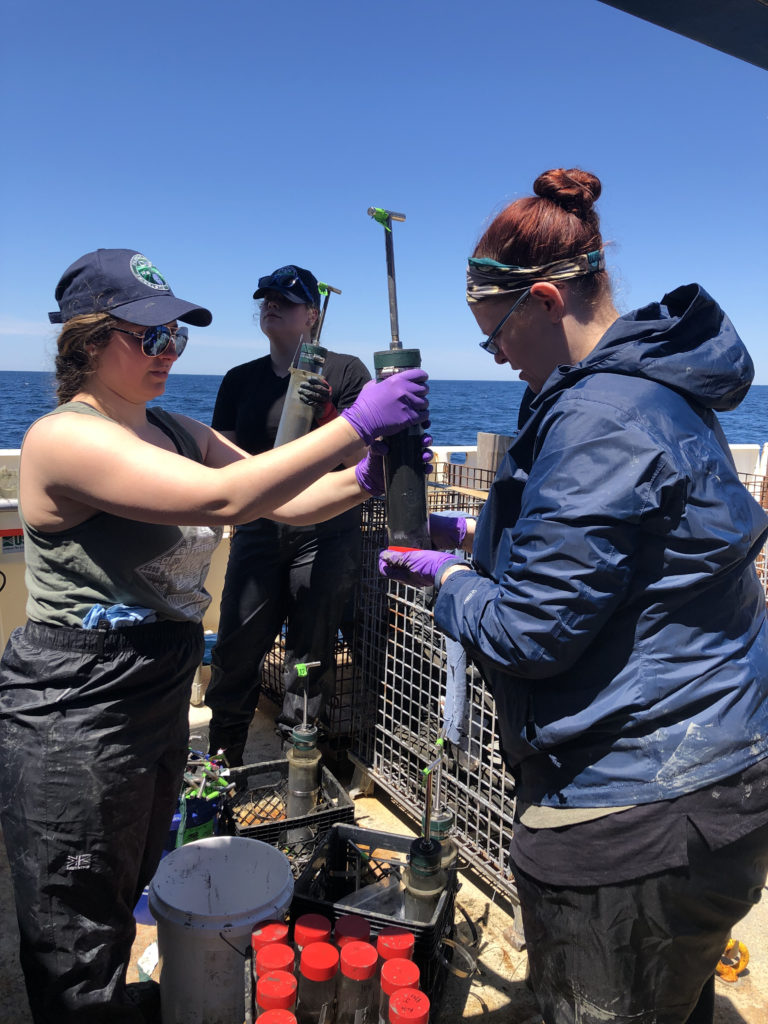Topic
Marine Technology

Sampling the Deep Sea
By Caitlin Adams, Operations Coordinator, NOAA Ocean Exploration
After spending Friday night in Morehead City, NC to avoid a storm front that affected the entire U.S. East Coast, the expedition team made our way back to sea to begin focused work in the canyon and seep habitats offshore North Carolina. The weather had not entirely calmed by the time we pulled away from the pier on Saturday morning, so we spent most of the day transiting to a selected coral site near Cape Lookout, and then mapping in the area, as there are significant gaps in seafloor mapping data there.

On Sunday morning, the seas and winds had finally settled enough for us to resume work with the remotely operated vehicle (ROV) Jason, designed and operated by Woods Hole Oceanographic Institution. Our first stop was Pamlico Canyon, which is about 20 miles offshore North Carolina’s Outer Banks. Submarine canyons are extreme environments in the deep sea: they can be as deep and as wide as the Grand Canyon, but they also cut deeply and narrowly into the continental shelf, acting as funnels from the shallow shelf seafloor to the plains of the deep sea. The canyon walls often have visible striations and are studded with cliffs and rocky outcroppings. Because of their unique geology, canyons also often have unique current patterns and large amounts of suspended sediments in the water column. All of this is to say: they are not the easiest environments in which to operate an ROV. But luckily for us, we have an experienced ROV team that is always ready to face a new challenge.

Our dive at Pamlico Canyon was our longest yet of this expedition, clocking in at nearly 20 hours on the seafloor. From the ship, the ROV pilots remotely navigated the ROV to the canyon (nearly 1,900 meters down) and spent most of the dive slowly climbing up from there, surveying the canyon’s walls and ledges. We saw spectacular rock faces, many of which were covered in starfish (order Brisingida), cup corals, and other deep-sea animals that get their food from particles passing by in the water. We also observed different fish species like skates and cusk eels as well as an octopus, red crabs, spider crabs, squat lobsters, and sea spiders (class Pycnogonida). We were able to collect excellent samples of our target coral species (Acanthogorgia and Desmophyllum) as well as four sets of sediment core samples for further study. By the time we recovered the ROV at 4pm on Monday afternoon, the ROV’s sample basket was completely full, and we knew we had a full night of work ahead of us!

The recovery process for ROV Jason is now a well-practiced ritual for the expedition team. Everyone who is awake heads to the back deck once the ROV is secured onboard, and a few people head straight to the basket to begin gathering all of our samples. They then pass those samples off to the rest of the team: collection containers are transported immediately to the cold room, while the core samples get carried over to the outdoor sink on the back deck. There, the mud teams remove each core from its outer housing and secure a cap on the top and bottom of each core tube before also bringing them into the cold room.

Once all of the samples are off the ROV and appropriately stored, the real work begins—sorting and processing a basket as full as the one we collected from Pamlico Canyon can easily take another 24 hours! For more on this expedition check out the mission logs, including this log on what happens with samples when the team goes back to their lab.
